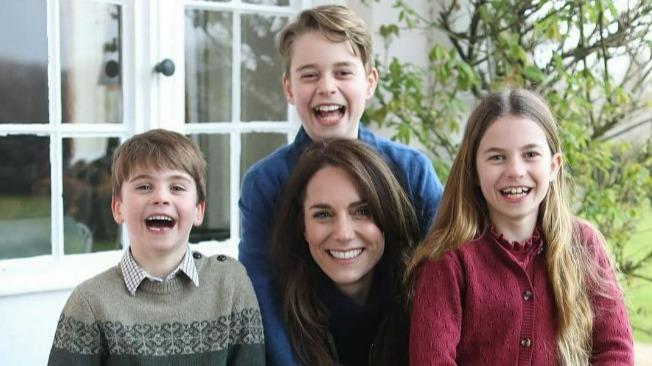Élodie Laye Mielczareck is a semiologist, specialized in the analysis of language, author of several works, consultant, speaker at Paris Cité University, currently in a doctorate on the theme of secularism and multiculturalism at UBFC. She is notably the author of
What gestures and words say about others... and especially about idiots
(Courrier du livre, 2023).
To discover
PODCAST - Listen to the club Le Club Le Figaro Idées with Eugénie Bastié
Hospitalized in February, the Princess of Wales has since continued to agitate social networks.
Sometimes operated on
"the abdomen" (according to the press release published by Kesington Palace), sometimes for
"gynecological"
reasons
, Kate Middleton's health is of concern.
Since his release from the clinic, only one stolen photograph has finally been published by an American media outlet.
Black glasses, swollen face, the Princess of Wales is driven by her mother.
It's the beginning of March, this is the first photograph of Prince William's wife since December.
By wanting to play the card of communicational sobriety, the British Palace made a mistake.
A few days ago, in a twist, another photograph surfaced, this time published on the couple's official account @KesingtonRoyal.
The staging is idyllic: Kate in the center, resplendent in the middle of her three children who exude the joy of living.
The message is simple: it celebrates Mother's Day.
Kate also thanks for the messages of support over the past two months.
No less was needed to trigger the detective passions of the public, who are not mistaken.
Quickly, the photograph turns out to be retouched.
If some Internet users denounce teeth that are too offset or missing fingers, other more professional views highlight the “blurred” contours of knees or hair, traces of a certain amateurism.
Even more surprising, the clothes appear to be the same ones the family wore in December.
Faced with these enormities, did Kate Middleton feel forced to publicly confess?
We could thus read on
Monday
morning , still on
the
official
The photograph has indeed been retouched (and is undoubtedly back-dated).
Since this revelation, memes have followed one another, hijacking the background (which transforms into a lunar station) or Kate's face (another character is there).
Here is the context.
Such an event, as anecdotal as it seems, nevertheless invites in-depth reflection on the dynamics of communication within digital devices, and to question our new relationship to information, and more specifically to truth.
By passing off the image as something it-was-as-is, the bond of trust is broken.
Kate Middleton
If everyone puts themselves on stage and takes a selfie, a practice which harkens back to the era of narcissism, it is also customary to “maximize” one's presence and presence by retouching dark circles or white hair that is too apparent.
From this point of view, Kate Middleton's approach is banal (and understandable).
However, this argument for the banality of the selfie misses the fundamental question of the enunciator.
The legitimacy possessed by Kate Middleton implies rights and duties.
Within this particular digital system, the official X account is a sounding board like the microphone of a head of state was in its time.
We must think of the digital device as a specific communication space.
It is because she is a singular voice of the royal monarchy that Kate Middleton represents beyond herself: she is a symbol.
Is it necessary to recall here the distinction, often stated, by Kantorowicz on “the two bodies of the King”?
Each member of the royal family represents a divine symbol, if not transcendental, which exceeds it both literally and figuratively.
It is no longer sufficient in itself, it overflows (with signs, history, meaning).
Above the Law, while being perfectly “legal” and guaranteed by the Law,
recalls the historian.
If the question of photographic retouching escapes any judicial notion, it nonetheless calls into question the field of ethics.
The particular status of the photographic image, a message without a code at first sight, says Barthes, implies certain precautions.
If words manipulate, photography speaks “the truth”.
Indeed, if the image cannot be confused with reality, it is
the perfect analogue
.
As a result, the princely “retouch” is not only an aesthetic fault (proof of amateurism, it has been said), it marks a breach of a moral contract.
By passing off the image as something it-was-as-is, the bond of trust is broken.
Because the image is conversational: it engages the viewer who becomes a stakeholder.
And, if we suspect the staging of the “facade” as Goffman would say, in its most positive and idyllic aspects (Kate is a mother filled with love and happy), and the issues of symbolic representations (the perfection of bodies expected at royal rank), all in an overplayed atmosphere, we expect less that the image “manipulate” us and lie to us.
Let's imagine another scenario of this event: Kate makes no public statement.
Are those who think the photo is “faked” then “conspirators”?
Without a way to verify the veracity of this fact, any questioning of an official version is subject to this label.
Often thought of in a unilateral and pyramidal manner, the notion of conspiracy is complex; we do not claim to cover it here.
Simply, let us note a tendency, particularly frequent, to label any official questioning by the “mass” as being incorrect, improper or even imbecile.
Christopher Lasch states:
“The population's distrust of those who exercise power has made society increasingly difficult to govern – as the ruling class constantly laments – without understanding that it is , in part, responsible.”
Seen from this angle, the public speaking of the Princess of Wales realigns with a modernist heritage (versus post-modernist) where the regime of truth and reason still makes sense.
It restores order, within a digital system (however) subject to the relativism of subjectivities.
Furthermore, politics, and the divine since we are talking about royalty, cannot be confused with advertising: they are committed to still being the trace of a certain truthfulness.

